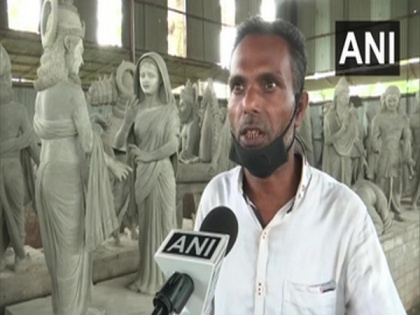Assam based sculptor making Ramayana-based statues for Ayodhya's Ram Temple since 2013
By ANI | Published: August 2, 2020 08:21 PM2020-08-02T20:21:12+5:302020-08-02T20:35:02+5:30
An Assam-based sculptor Ranjit Mandal is making statues depicting Lord Ram's journey, from childhood till coronation, since 2013 in Ayodhya.

Assam based sculptor making Ramayana-based statues for Ayodhya's Ram Temple since 2013
An Assam-based sculptor Ranjit Mandal is making statues depicting Lord Ram's journey, from childhood till coronation, since 2013 in Ayodhya.
These statues will be put for display in the courtyard of Ram Temple, the foundation stone of which will be laid out on August 5.
Speaking to , Ranjit said that 'Ram Katha Kunj' is an idea to recreate Ramayana through idols.
"My home is in Assam but Ashok Singhal (late VHP leader) brought me here in 1997. I started making idols from Class V. I started this work (making idols for Ram Katha Kunj) in 2013. I am proud that Ram Katha Kunj will be put up in Ram Temple courtyard. I have tried to make statues depicting Lord Ram's journey from childhood till coronation," he said.
He said that 'Ram Katha Kunj' will have 125 scripts from Ram's life which will be put for the exhibition. He said that it takes around three months to complete one script.
"There are 125 scripts in Ram Katha Kunj. For one script, it takes around three months. The work is underway at a rapid pace after lockdown," Ranjit said.
Mandal said that statues till 'Sita Haran' (a scene in Ramayana in which Ravana abducts Sita, wife of Lord Ram) episode are ready and work is underway to complete the rest.
"Our statues are ready till Sita Haran and the remaining work is underway in full swing," he said.
Speaking about the design of statues, Ranjit, who hails from Assam's Silchar said that these idols are an amalgamation of styles from two different states -- West Bengal and Uttar Pradesh.
"Idols are an amalgamation of Bengal style and Uttar Pradesh style. As the clothes are based on Bengal style, the body of the idols is designed as per Uttar Pradesh style," he said.
"Present work is working smoothly and after lockdown, it will fasten," said Silchar-based sculptor, who uses cement, steel wire, and steel mesh for making these sculptures.
His father, Narayan Chandra Mandal, joined him in 2015 to create statues for 'Ram Katha Kunj' and since then both working are working together.
"I came to Ayodhya in 2015 to help my son. Singhal ji brought me here. I am helping by doing work of iron rod bending and cement work. My son is the main sculpture and I am only helping my child. This is Karma of my past life that we got this opportunity to contribute for the Ram Temple. I am a proud father as my son's work will be on display," Narayan told .
Meanwhile, the work at the stone-carving workshop of Ram Janambhoomi in Ayodhya has reached its final stage. The stone-carving workshop for the Ram temple construction was established in Ayodhya by the Vishwa Hindu Parishad (VHP) in 1990.
Preparations, including a cleanliness drive and stisation, are underway in Ayodhya ahead of the foundation laying ceremony of the Ram Temple. People were seen cleng the roads, markets, and ghats.
Several areas in Ayodhya are being illuminated with diyas (earthen lamps) and colourful lights.
According to potters in the state, around 1.25 lakh diyas were ordered for the highly anticipated ceremony on August 5.
PM Modi is scheduled to lay the foundation stone of the Ram Temple in Ayodhya on August 5, according to Mahant Nritya Gopal Das, the president of the Sri Ram Janmabhoomi Teertha Kshetra Trust.
The construction of the Ram temple will begin after the ceremony to lay the foundation stone in which Chief Ministers of several states, Ministers from the Union Cabinet and RSS chief Mohan Bhagwat are also likely to participate.
On November 9, 2019, a five-judge Supreme Court bench led by then Chief Justice of India (CJI) Ranjan Gogoi ruled in favour of Ram Lalla and said the entire disputed land spread over 2.7 acres will be handed over to a trust formed by the government, which will monitor the construction of a Ram Temple at the site.
( With inputs from ANI )
Open in app